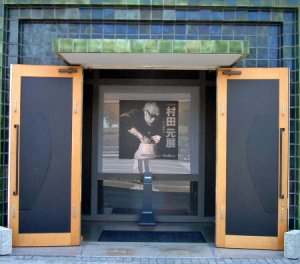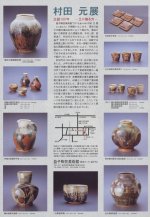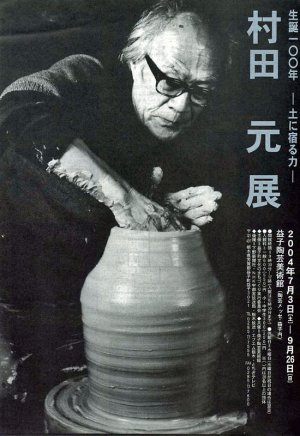|
Murata Gen Exhibition at the
Mashiko Museum of Ceramic Art
from July 3 to Sept. 26, 2004
Story by Robert Yellin
Adapted from his article first appearing in
DARUMA Magazine, Issue 32, Autumn 2001

Entrance to Museum, with Photo of Murata Gen
The twentieth century brought about a Renaissance for the Japanese pottery world. Old traditions were revived, with Bizen, Karatsu and Shino in the forefront, while new ones were born in the work of Sodeisha members and Kamoda Shoji. The general populace also found a renewed interest in the products of clay and fire.
|
|

Jump Directly To
Murata Gen
Photo Tour
Over 50 Works
Mashiko Museum of Ceramic Art
3021 Mashiko, Mashiko City
Haga-gun, Tochigi 321-4217
TEL: 0285-72-7555
Open: 9:30 - 16:30
Closed: Wednesday

|
|
|
|
|
This led to an increase in the number of independent studio potters who came into their own through the efforts of Itaya Hazan and Tomimoto Kenkichi. Their works and teachings inspired countless potters; among Itaya's students was Hamada Shoji. Tomimoto taught many as well, including Kamoda.
Books published in the 1960s and 1970s showed the works and marks of the thousand of potters working throughout the country; thus the great interest seen amongst the public. Most of the books originated with Kuroda Ryoji, the late proprietor of Ginza Kuroda Toen, and were published by Kogei Shuppan (incidentally the publishers of Yellin's Japanese shuki book).
Most listed potters, though, never made a name for themselves beyond their local towns and many have faded into the great ceramic history that is deeply rooted in Japanese culture.
That is unfortunate. Many fine talents never had the correct political alignment so were overlooked even though they made outstanding pots. Others were content to stay local, while some just never had the good fortune to be associated with a top gallery.
One such potter was Murata Gen (1904 - 1988)
I'll never forget the first time I saw his work. It was in a small coffee shop-cum-gallery hosting a Mashiko-yaki yunomi (teacup) exhibition. Ironically, the shop was named Rosanjin after the eccentric artist who thought Mashiko-yaki and the Mingei movement were a total farce! Murata's yunomi had nothing fancy about it; traditional shape, sturdy and honest with powerful iron brush strokes over the creamy nuka glaze. Yet in that simplicity was a depth I'd never encountered in such a common form. It was as if the cup was breathing, such was the spirit of Murata within.

 Murata Gen was born the second son of Murata Tasaburo and Retsu in 1904. The Muratas were farmers in Ishikawa Prefecture located next to the Sea of Japan. Even though the family was better off than most, Murata was not blessed with a happy childhood, having been separated from his mother after his parents divorced. His grandmother Yoko raised him. From an early age Murata was fond of art and wanted to pursue his artistic visions as a career. He dropped out of junior high school, studied painting in Kyoto (delivered papers to support himself) until he entered the Kansai Art Academy (Kansai Bijutsu Gakuin) in 1922. Upon graduation he was married and moved to Tokyo to work editing, illustrating and designing magazines. This experience led him to become the editor of Senki (War Flag), the journal for the Japan Proletarian Artists' Association. Murata Gen was born the second son of Murata Tasaburo and Retsu in 1904. The Muratas were farmers in Ishikawa Prefecture located next to the Sea of Japan. Even though the family was better off than most, Murata was not blessed with a happy childhood, having been separated from his mother after his parents divorced. His grandmother Yoko raised him. From an early age Murata was fond of art and wanted to pursue his artistic visions as a career. He dropped out of junior high school, studied painting in Kyoto (delivered papers to support himself) until he entered the Kansai Art Academy (Kansai Bijutsu Gakuin) in 1922. Upon graduation he was married and moved to Tokyo to work editing, illustrating and designing magazines. This experience led him to become the editor of Senki (War Flag), the journal for the Japan Proletarian Artists' Association.
He first came across pottery when visiting a folk craft exhibition in 1934 at Matsuzakaya in Ueno, Tokyo. It was a Mashiko-yaki yunomi by Sakuma Totaro, Hamada's first friend when he relocated there in 1924.
Yet it was to be a few years before Murata could make the break from poor editor (having to live in a 'hideaway' because he couldn't pay his bills, married with kids no less) to poor potter. Yearning to be a potter, especially after seeing Hamada Shoji's work in 1943, he made the move to Mashiko, Tochigi Prefecture in 1944. A well-connected friend suggested he write a letter to Hamada asking him to take Murata in as an apprentice. Murata wanted nothing to have of that and would introduce himself, waiting at the gate like an aspiring monk if need be.
Mashiko, like the rest of Japan, was feeling the ravages of war (Murata did serve time in the army) and Hamada had no place for an apprentice to stay. Food was scarce, often nothing at all, as were supplies for the pottery. Yet Hamada -- impressed by Murata's determination -- told Murata if he could find a place to stay, he (Hamada) offered to take him on. Murata worked with Hamada for four years and became an independent potter thereafter, even though he had no kiln. Potters then often rented space in others' kilns.
Murata lived in an old decrepit house (one person described it as a "chicken shed"). In those days he had to wheel his to-be fired works to the nearby kiln along a bumpy road; much of the work was tossed about, some even broke. In the winter the cold winds made his shack an ice zone and some unfired pots would freeze and crack. Yet, not even that broke Muarta's will and he was able to build his first kiln, a climbing chambered noborigama, in 1954. He was 50 years old.

The year before Bernard Leach visited Mashiko and taught Murata how to make pitchers, especially the technique of attaching the handle.
At long last, he had his first exhibition in 1955 at Izumi Kogei craft shop in Tokyo. Murata Gen had finally arrived.
Murata was a consummate Mashiko potter, only using local materials that give any Japanese pottery its regional and distinctive qualities. For Mashiko pottery that includes local clay of course, as well as traditional glazes such as nuka (rice husk), kaki-yu (persimmon) and iron tinged. In his later years, Murata created his own style of layering these glazes that gave his sturdy jars a painterly aura. There is a great intelligence and sensitivity in Murata's work that draws upon his dreams of being a painter, his literary experiences, and his extremely impoverished life.
He was also quite dogmatic and this led him into conflicts with Mingei founder Yanagi Soetsu. This is one reason you don't find Murata's work in the Mingeikan (Japan Folks Craft Museum) in Tokyo although most other major Mashiko potter of those days is represented. Why is this so? Yanagi told Murata, "You sign your work, and so it really isn't Mingei; you're off the Mingei path." Yanagi blacklisted Murata, so to speak. Yet, Murata was adamant that the public should be able to know who made what and went on stamping his work with 'mu' or signing 'mu' within a diamond.
After two decades creating his own distinctive voice in Mashiko, he was able to build his first house ever in 1967. He never stopped refining his art and even built a new kiln when he was 71. In 1985, Tochigi prefecture honored Murata with its highest award for artistic contribution, the Cultural Merit Award.
Murata Gen's "simple," deep, and passionate ceramic art deserves to be seen by all who endear Mashiko. In my mind, he is the finest traditional Mashiko potter the world has ever known.

PHOTO TOUR OF WORK BY MURATA GEN

LEARN MORE

|